Low Carbon Building Design: Approaches, Embodied Energy and Carbon Calculation, and Comparison with Original Model
VerifiedAdded on 2022/10/01
|17
|1972
|186
AI Summary
This document discusses the approaches applied in selecting construction materials to minimize embodied energy and carbon of a redesigned home, as well as the embodied energy and carbon calculation of selected materials. It also provides a comparison of energy consumption and carbon emission between the original and redesigned models. Additionally, it identifies design parameters to consider if the building is located in a hot climate region.
Contribute Materials
Your contribution can guide someone’s learning journey. Share your
documents today.
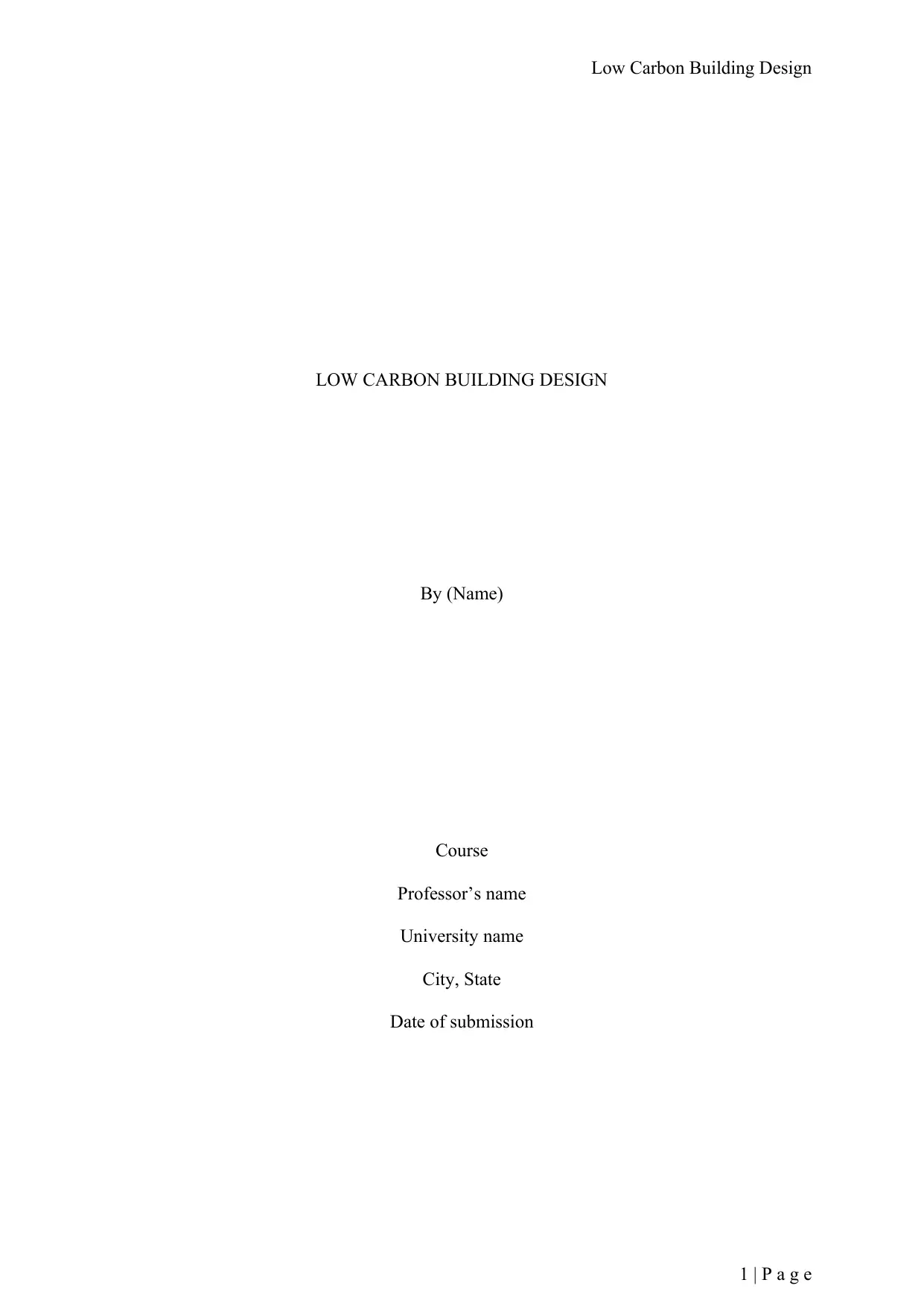
Low Carbon Building Design
LOW CARBON BUILDING DESIGN
By (Name)
Course
Professor’s name
University name
City, State
Date of submission
1 | P a g e
LOW CARBON BUILDING DESIGN
By (Name)
Course
Professor’s name
University name
City, State
Date of submission
1 | P a g e
Secure Best Marks with AI Grader
Need help grading? Try our AI Grader for instant feedback on your assignments.
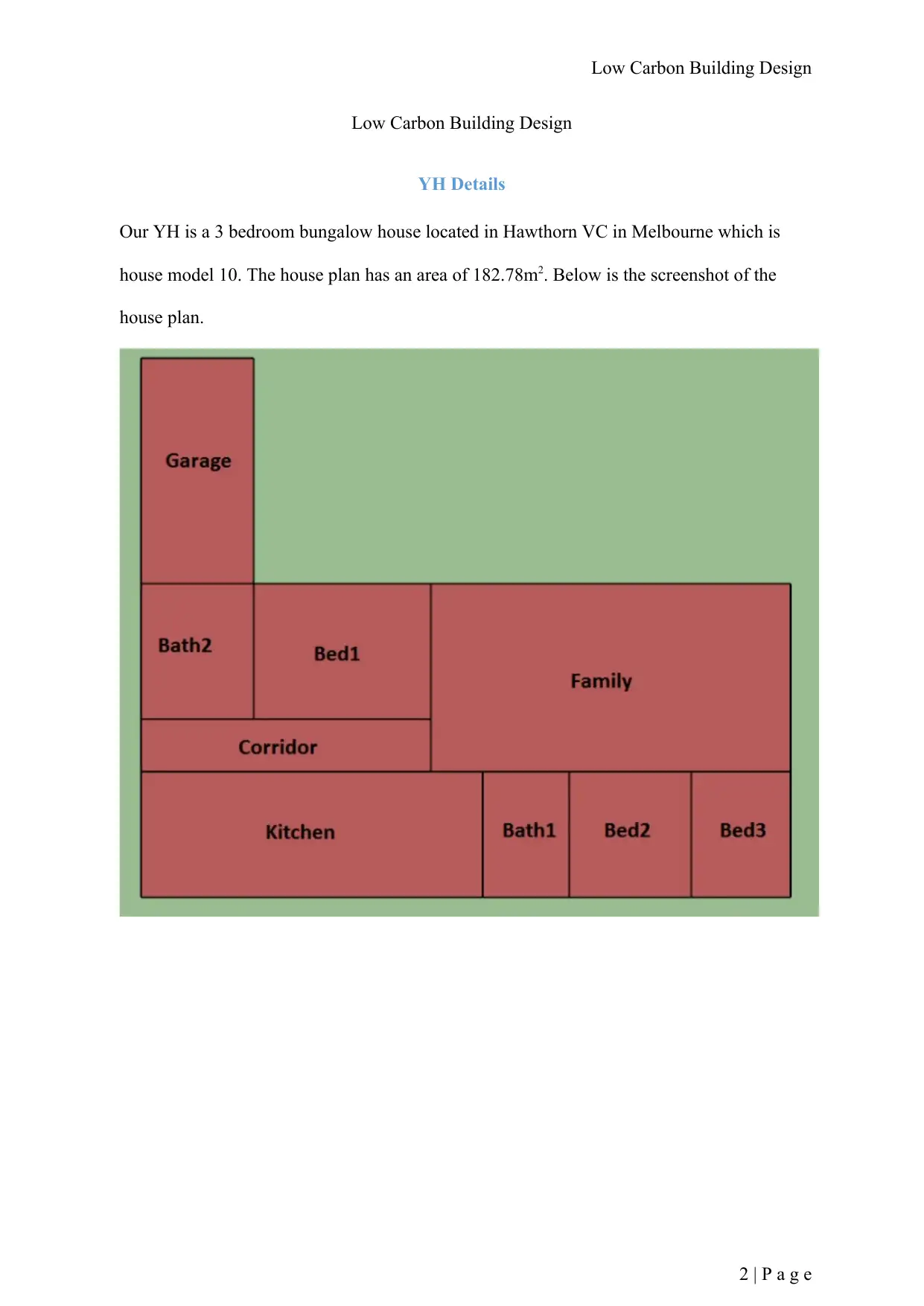
Low Carbon Building Design
Low Carbon Building Design
YH Details
Our YH is a 3 bedroom bungalow house located in Hawthorn VC in Melbourne which is
house model 10. The house plan has an area of 182.78m2. Below is the screenshot of the
house plan.
2 | P a g e
Low Carbon Building Design
YH Details
Our YH is a 3 bedroom bungalow house located in Hawthorn VC in Melbourne which is
house model 10. The house plan has an area of 182.78m2. Below is the screenshot of the
house plan.
2 | P a g e
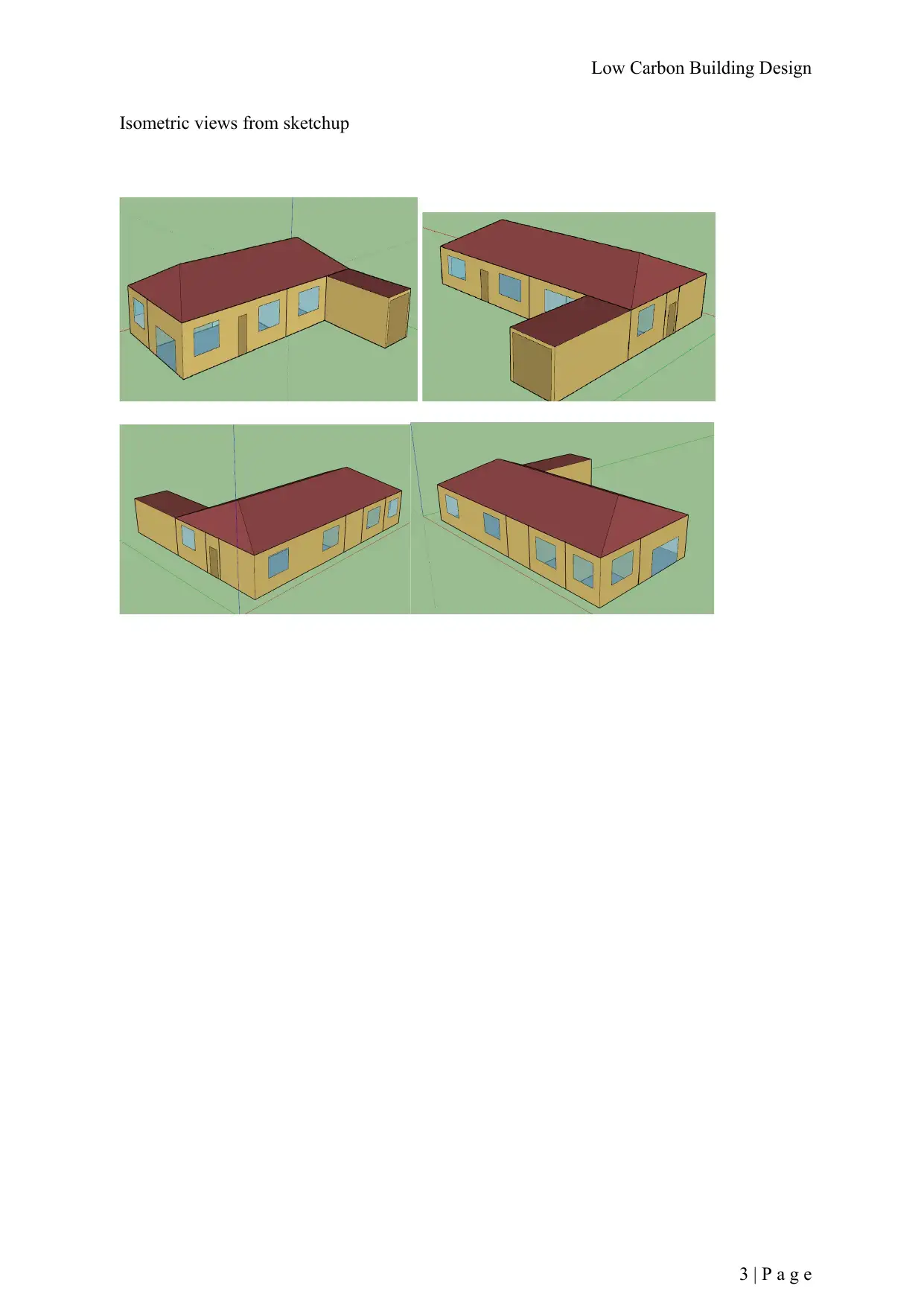
Low Carbon Building Design
Isometric views from sketchup
3 | P a g e
Isometric views from sketchup
3 | P a g e
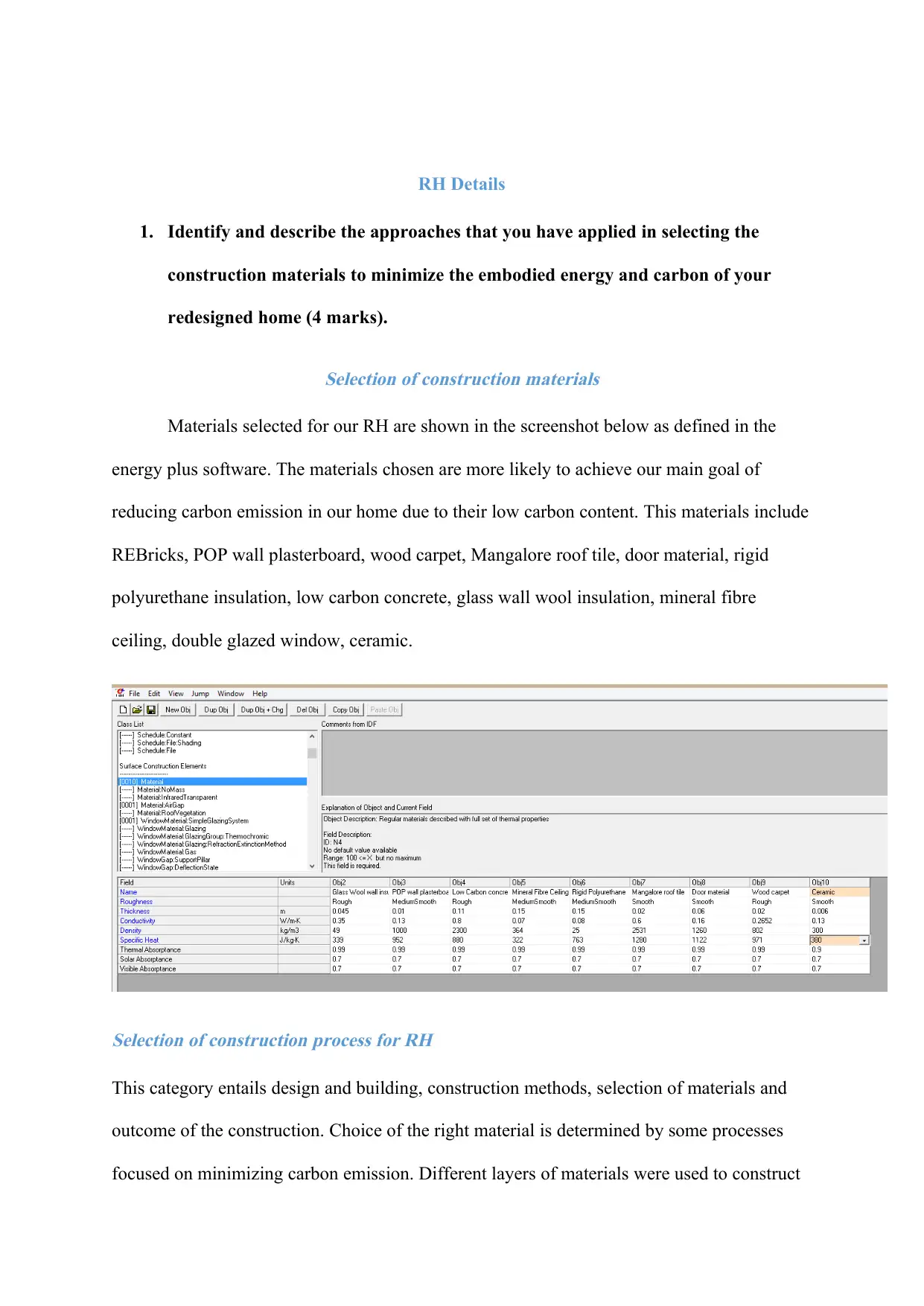
RH Details
1. Identify and describe the approaches that you have applied in selecting the
construction materials to minimize the embodied energy and carbon of your
redesigned home (4 marks).
Selection of construction materials
Materials selected for our RH are shown in the screenshot below as defined in the
energy plus software. The materials chosen are more likely to achieve our main goal of
reducing carbon emission in our home due to their low carbon content. This materials include
REBricks, POP wall plasterboard, wood carpet, Mangalore roof tile, door material, rigid
polyurethane insulation, low carbon concrete, glass wall wool insulation, mineral fibre
ceiling, double glazed window, ceramic.
Selection of construction process for RH
This category entails design and building, construction methods, selection of materials and
outcome of the construction. Choice of the right material is determined by some processes
focused on minimizing carbon emission. Different layers of materials were used to construct
1. Identify and describe the approaches that you have applied in selecting the
construction materials to minimize the embodied energy and carbon of your
redesigned home (4 marks).
Selection of construction materials
Materials selected for our RH are shown in the screenshot below as defined in the
energy plus software. The materials chosen are more likely to achieve our main goal of
reducing carbon emission in our home due to their low carbon content. This materials include
REBricks, POP wall plasterboard, wood carpet, Mangalore roof tile, door material, rigid
polyurethane insulation, low carbon concrete, glass wall wool insulation, mineral fibre
ceiling, double glazed window, ceramic.
Selection of construction process for RH
This category entails design and building, construction methods, selection of materials and
outcome of the construction. Choice of the right material is determined by some processes
focused on minimizing carbon emission. Different layers of materials were used to construct
Secure Best Marks with AI Grader
Need help grading? Try our AI Grader for instant feedback on your assignments.
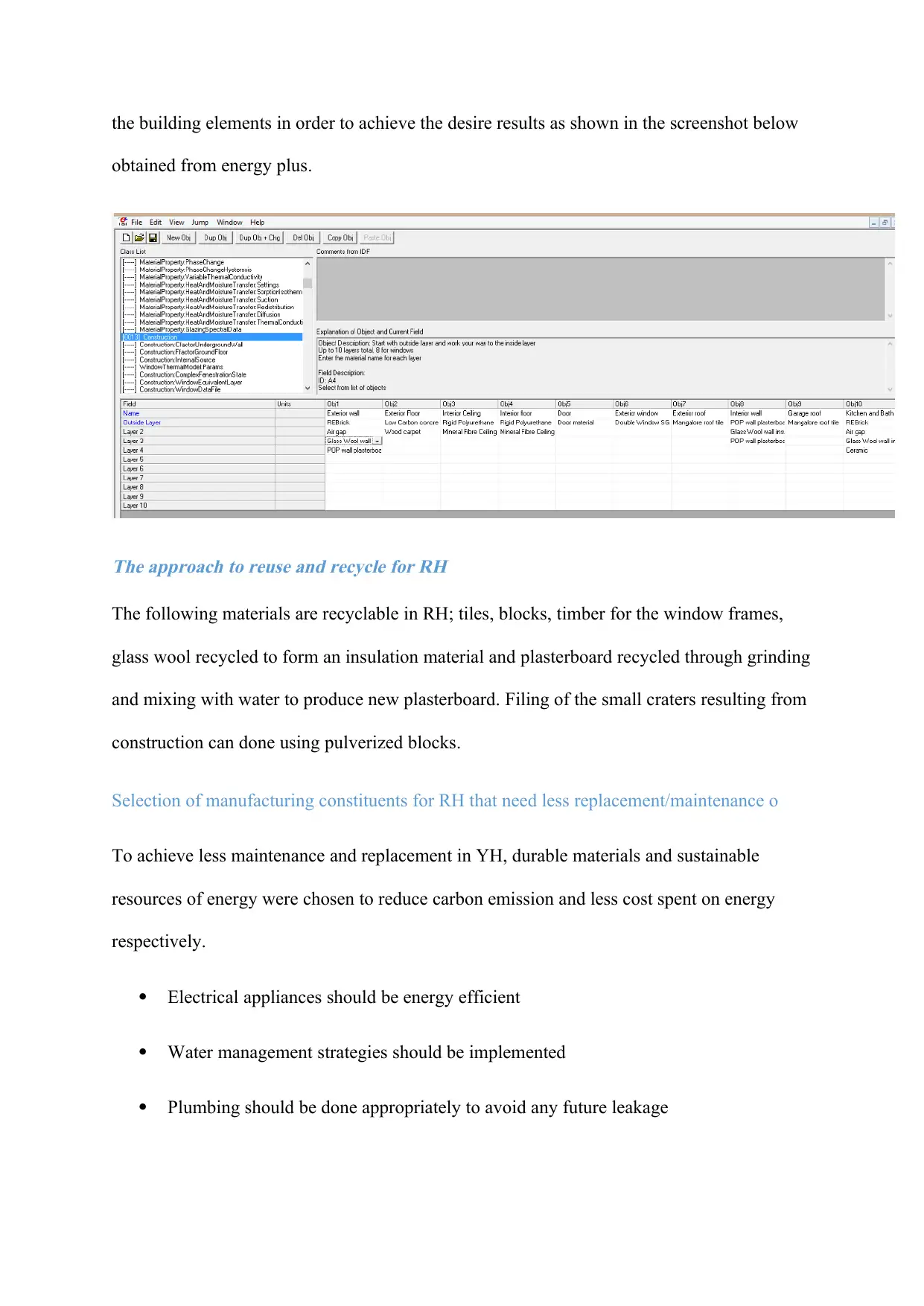
the building elements in order to achieve the desire results as shown in the screenshot below
obtained from energy plus.
The approach to reuse and recycle for RH
The following materials are recyclable in RH; tiles, blocks, timber for the window frames,
glass wool recycled to form an insulation material and plasterboard recycled through grinding
and mixing with water to produce new plasterboard. Filing of the small craters resulting from
construction can done using pulverized blocks.
Selection of manufacturing constituents for RH that need less replacement/maintenance o
To achieve less maintenance and replacement in YH, durable materials and sustainable
resources of energy were chosen to reduce carbon emission and less cost spent on energy
respectively.
Electrical appliances should be energy efficient
Water management strategies should be implemented
Plumbing should be done appropriately to avoid any future leakage
obtained from energy plus.
The approach to reuse and recycle for RH
The following materials are recyclable in RH; tiles, blocks, timber for the window frames,
glass wool recycled to form an insulation material and plasterboard recycled through grinding
and mixing with water to produce new plasterboard. Filing of the small craters resulting from
construction can done using pulverized blocks.
Selection of manufacturing constituents for RH that need less replacement/maintenance o
To achieve less maintenance and replacement in YH, durable materials and sustainable
resources of energy were chosen to reduce carbon emission and less cost spent on energy
respectively.
Electrical appliances should be energy efficient
Water management strategies should be implemented
Plumbing should be done appropriately to avoid any future leakage
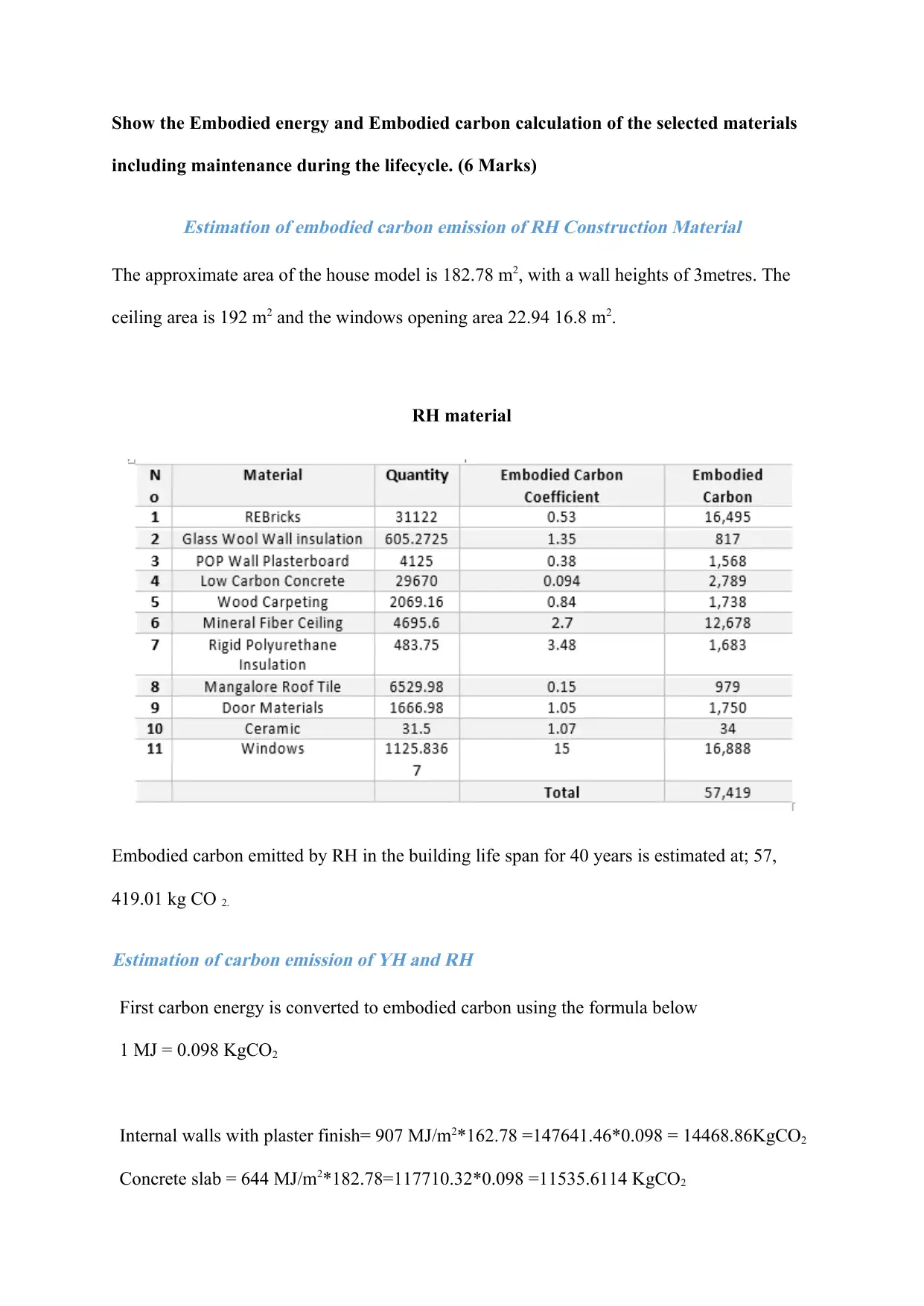
Show the Embodied energy and Embodied carbon calculation of the selected materials
including maintenance during the lifecycle. (6 Marks)
Estimation of embodied carbon emission of RH Construction Material
The approximate area of the house model is 182.78 m2, with a wall heights of 3metres. The
ceiling area is 192 m2 and the windows opening area 22.94 16.8 m2.
RH material
Embodied carbon emitted by RH in the building life span for 40 years is estimated at; 57,
419.01 kg CO 2.
Estimation of carbon emission of YH and RH
First carbon energy is converted to embodied carbon using the formula below
1 MJ = 0.098 KgCO2
Internal walls with plaster finish= 907 MJ/m2*162.78 =147641.46*0.098 = 14468.86KgCO2
Concrete slab = 644 MJ/m2*182.78=117710.32*0.098 =11535.6114 KgCO2
including maintenance during the lifecycle. (6 Marks)
Estimation of embodied carbon emission of RH Construction Material
The approximate area of the house model is 182.78 m2, with a wall heights of 3metres. The
ceiling area is 192 m2 and the windows opening area 22.94 16.8 m2.
RH material
Embodied carbon emitted by RH in the building life span for 40 years is estimated at; 57,
419.01 kg CO 2.
Estimation of carbon emission of YH and RH
First carbon energy is converted to embodied carbon using the formula below
1 MJ = 0.098 KgCO2
Internal walls with plaster finish= 907 MJ/m2*162.78 =147641.46*0.098 = 14468.86KgCO2
Concrete slab = 644 MJ/m2*182.78=117710.32*0.098 =11535.6114 KgCO2
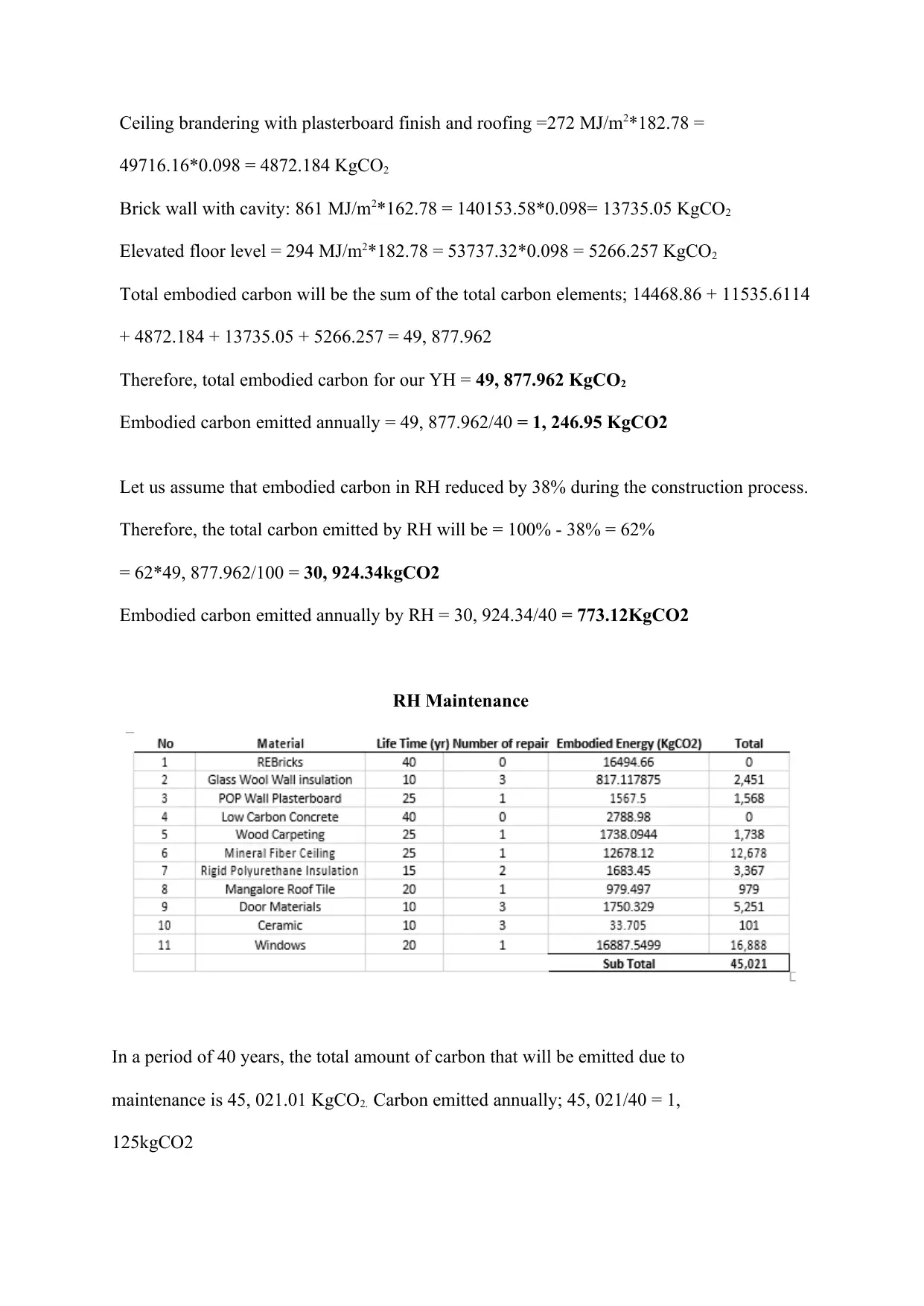
Ceiling brandering with plasterboard finish and roofing =272 MJ/m2*182.78 =
49716.16*0.098 = 4872.184 KgCO2
Brick wall with cavity: 861 MJ/m2*162.78 = 140153.58*0.098= 13735.05 KgCO2
Elevated floor level = 294 MJ/m2*182.78 = 53737.32*0.098 = 5266.257 KgCO2
Total embodied carbon will be the sum of the total carbon elements; 14468.86 + 11535.6114
+ 4872.184 + 13735.05 + 5266.257 = 49, 877.962
Therefore, total embodied carbon for our YH = 49, 877.962 KgCO2
Embodied carbon emitted annually = 49, 877.962/40 = 1, 246.95 KgCO2
Let us assume that embodied carbon in RH reduced by 38% during the construction process.
Therefore, the total carbon emitted by RH will be = 100% - 38% = 62%
= 62*49, 877.962/100 = 30, 924.34kgCO2
Embodied carbon emitted annually by RH = 30, 924.34/40 = 773.12KgCO2
RH Maintenance
In a period of 40 years, the total amount of carbon that will be emitted due to
maintenance is 45, 021.01 KgCO2. Carbon emitted annually; 45, 021/40 = 1,
125kgCO2
49716.16*0.098 = 4872.184 KgCO2
Brick wall with cavity: 861 MJ/m2*162.78 = 140153.58*0.098= 13735.05 KgCO2
Elevated floor level = 294 MJ/m2*182.78 = 53737.32*0.098 = 5266.257 KgCO2
Total embodied carbon will be the sum of the total carbon elements; 14468.86 + 11535.6114
+ 4872.184 + 13735.05 + 5266.257 = 49, 877.962
Therefore, total embodied carbon for our YH = 49, 877.962 KgCO2
Embodied carbon emitted annually = 49, 877.962/40 = 1, 246.95 KgCO2
Let us assume that embodied carbon in RH reduced by 38% during the construction process.
Therefore, the total carbon emitted by RH will be = 100% - 38% = 62%
= 62*49, 877.962/100 = 30, 924.34kgCO2
Embodied carbon emitted annually by RH = 30, 924.34/40 = 773.12KgCO2
RH Maintenance
In a period of 40 years, the total amount of carbon that will be emitted due to
maintenance is 45, 021.01 KgCO2. Carbon emitted annually; 45, 021/40 = 1,
125kgCO2
Paraphrase This Document
Need a fresh take? Get an instant paraphrase of this document with our AI Paraphraser
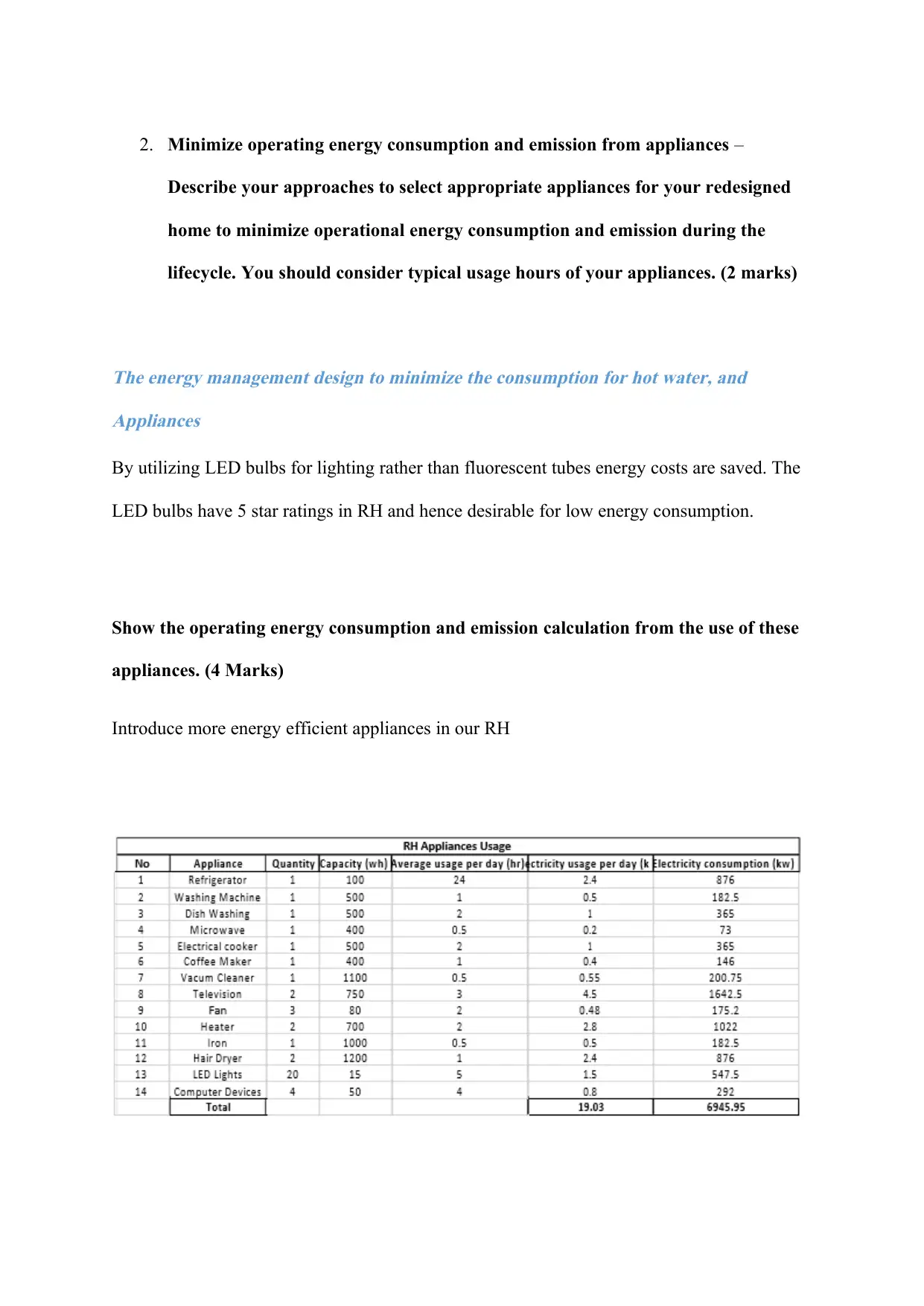
2. Minimize operating energy consumption and emission from appliances –
Describe your approaches to select appropriate appliances for your redesigned
home to minimize operational energy consumption and emission during the
lifecycle. You should consider typical usage hours of your appliances. (2 marks)
The energy management design to minimize the consumption for hot water, and
Appliances
By utilizing LED bulbs for lighting rather than fluorescent tubes energy costs are saved. The
LED bulbs have 5 star ratings in RH and hence desirable for low energy consumption.
Show the operating energy consumption and emission calculation from the use of these
appliances. (4 Marks)
Introduce more energy efficient appliances in our RH
Describe your approaches to select appropriate appliances for your redesigned
home to minimize operational energy consumption and emission during the
lifecycle. You should consider typical usage hours of your appliances. (2 marks)
The energy management design to minimize the consumption for hot water, and
Appliances
By utilizing LED bulbs for lighting rather than fluorescent tubes energy costs are saved. The
LED bulbs have 5 star ratings in RH and hence desirable for low energy consumption.
Show the operating energy consumption and emission calculation from the use of these
appliances. (4 Marks)
Introduce more energy efficient appliances in our RH
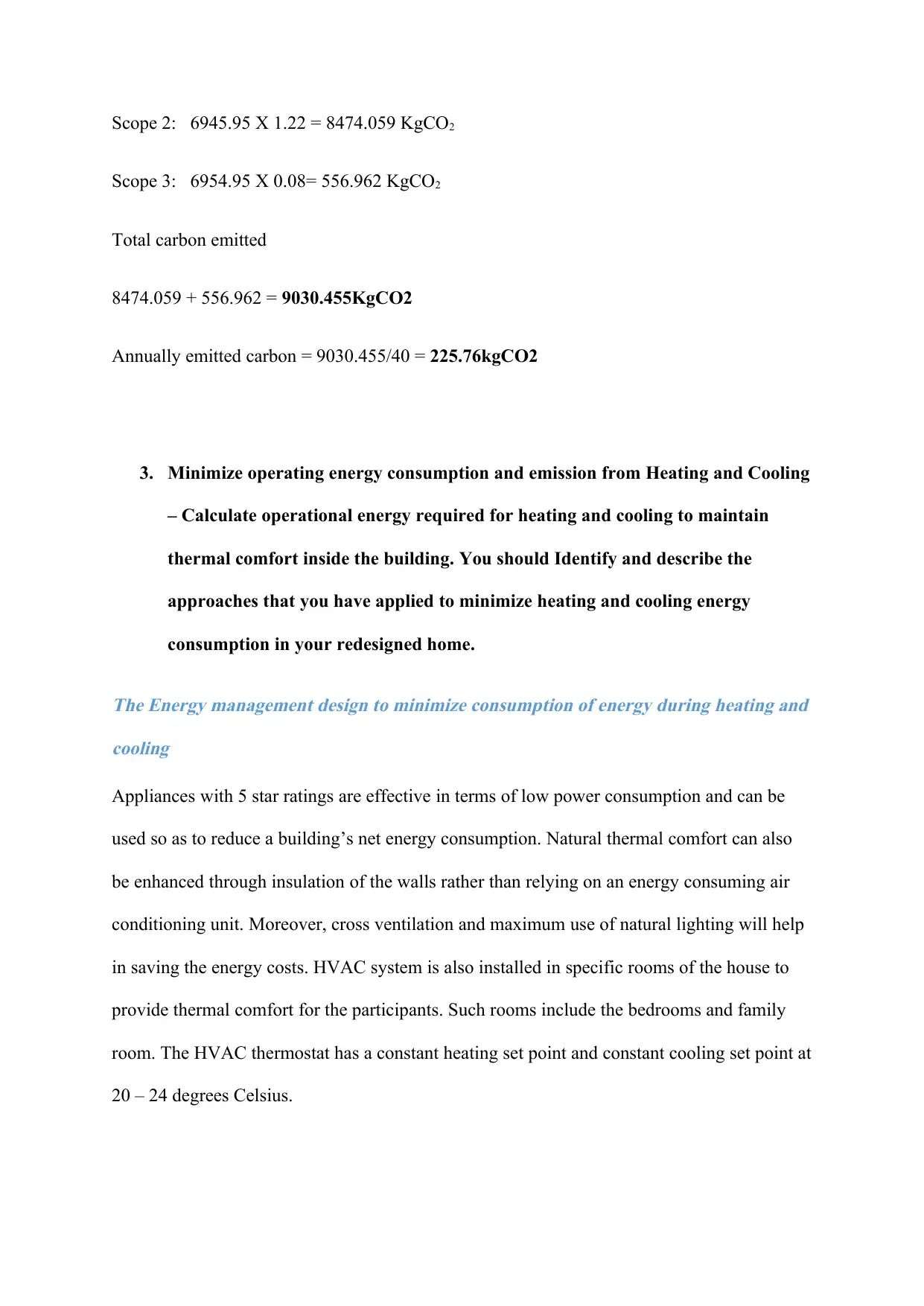
Scope 2: 6945.95 X 1.22 = 8474.059 KgCO2
Scope 3: 6954.95 X 0.08= 556.962 KgCO2
Total carbon emitted
8474.059 + 556.962 = 9030.455KgCO2
Annually emitted carbon = 9030.455/40 = 225.76kgCO2
3. Minimize operating energy consumption and emission from Heating and Cooling
– Calculate operational energy required for heating and cooling to maintain
thermal comfort inside the building. You should Identify and describe the
approaches that you have applied to minimize heating and cooling energy
consumption in your redesigned home.
The Energy management design to minimize consumption of energy during heating and
cooling
Appliances with 5 star ratings are effective in terms of low power consumption and can be
used so as to reduce a building’s net energy consumption. Natural thermal comfort can also
be enhanced through insulation of the walls rather than relying on an energy consuming air
conditioning unit. Moreover, cross ventilation and maximum use of natural lighting will help
in saving the energy costs. HVAC system is also installed in specific rooms of the house to
provide thermal comfort for the participants. Such rooms include the bedrooms and family
room. The HVAC thermostat has a constant heating set point and constant cooling set point at
20 – 24 degrees Celsius.
Scope 3: 6954.95 X 0.08= 556.962 KgCO2
Total carbon emitted
8474.059 + 556.962 = 9030.455KgCO2
Annually emitted carbon = 9030.455/40 = 225.76kgCO2
3. Minimize operating energy consumption and emission from Heating and Cooling
– Calculate operational energy required for heating and cooling to maintain
thermal comfort inside the building. You should Identify and describe the
approaches that you have applied to minimize heating and cooling energy
consumption in your redesigned home.
The Energy management design to minimize consumption of energy during heating and
cooling
Appliances with 5 star ratings are effective in terms of low power consumption and can be
used so as to reduce a building’s net energy consumption. Natural thermal comfort can also
be enhanced through insulation of the walls rather than relying on an energy consuming air
conditioning unit. Moreover, cross ventilation and maximum use of natural lighting will help
in saving the energy costs. HVAC system is also installed in specific rooms of the house to
provide thermal comfort for the participants. Such rooms include the bedrooms and family
room. The HVAC thermostat has a constant heating set point and constant cooling set point at
20 – 24 degrees Celsius.
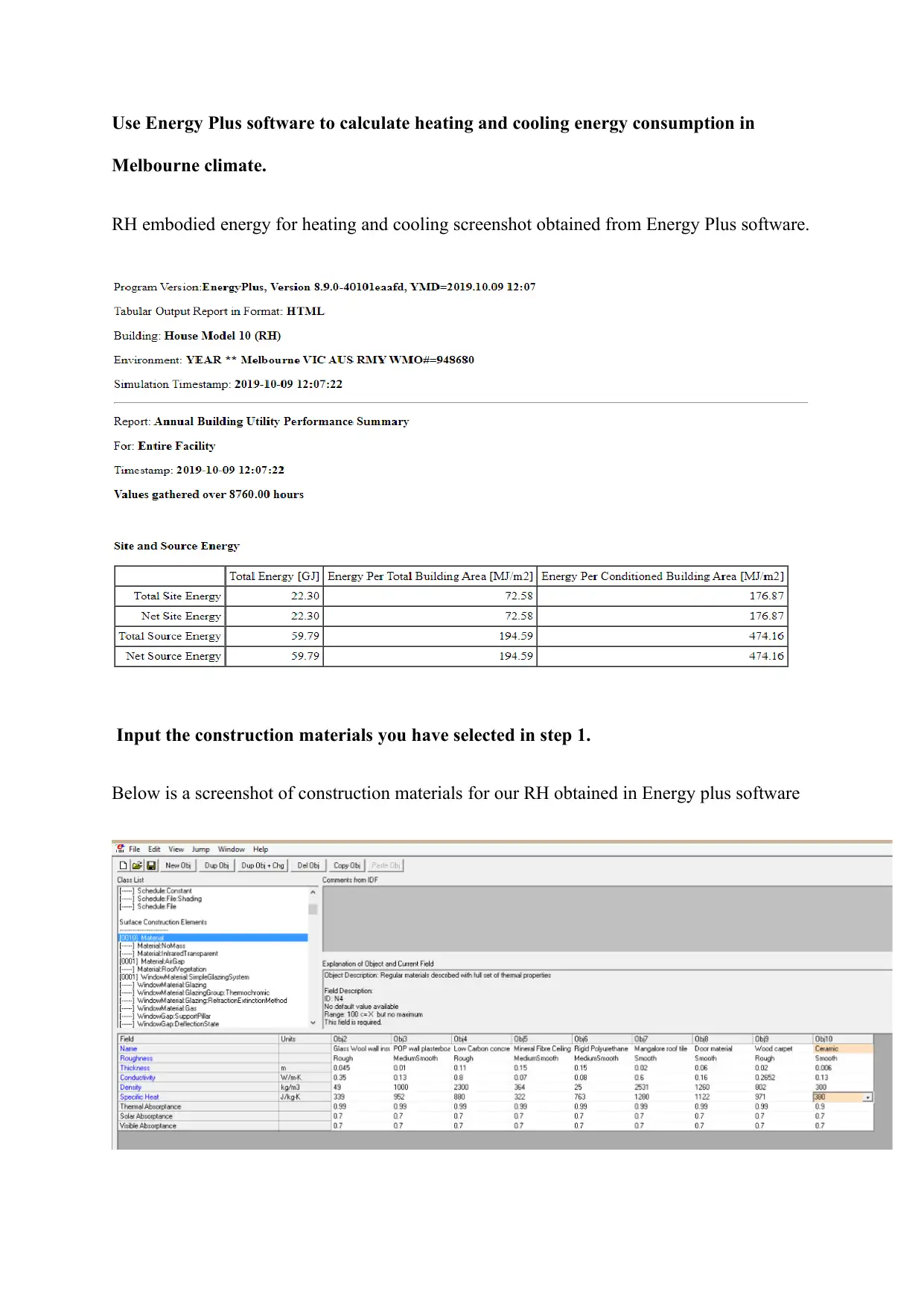
Use Energy Plus software to calculate heating and cooling energy consumption in
Melbourne climate.
RH embodied energy for heating and cooling screenshot obtained from Energy Plus software.
Input the construction materials you have selected in step 1.
Below is a screenshot of construction materials for our RH obtained in Energy plus software
Melbourne climate.
RH embodied energy for heating and cooling screenshot obtained from Energy Plus software.
Input the construction materials you have selected in step 1.
Below is a screenshot of construction materials for our RH obtained in Energy plus software
Secure Best Marks with AI Grader
Need help grading? Try our AI Grader for instant feedback on your assignments.
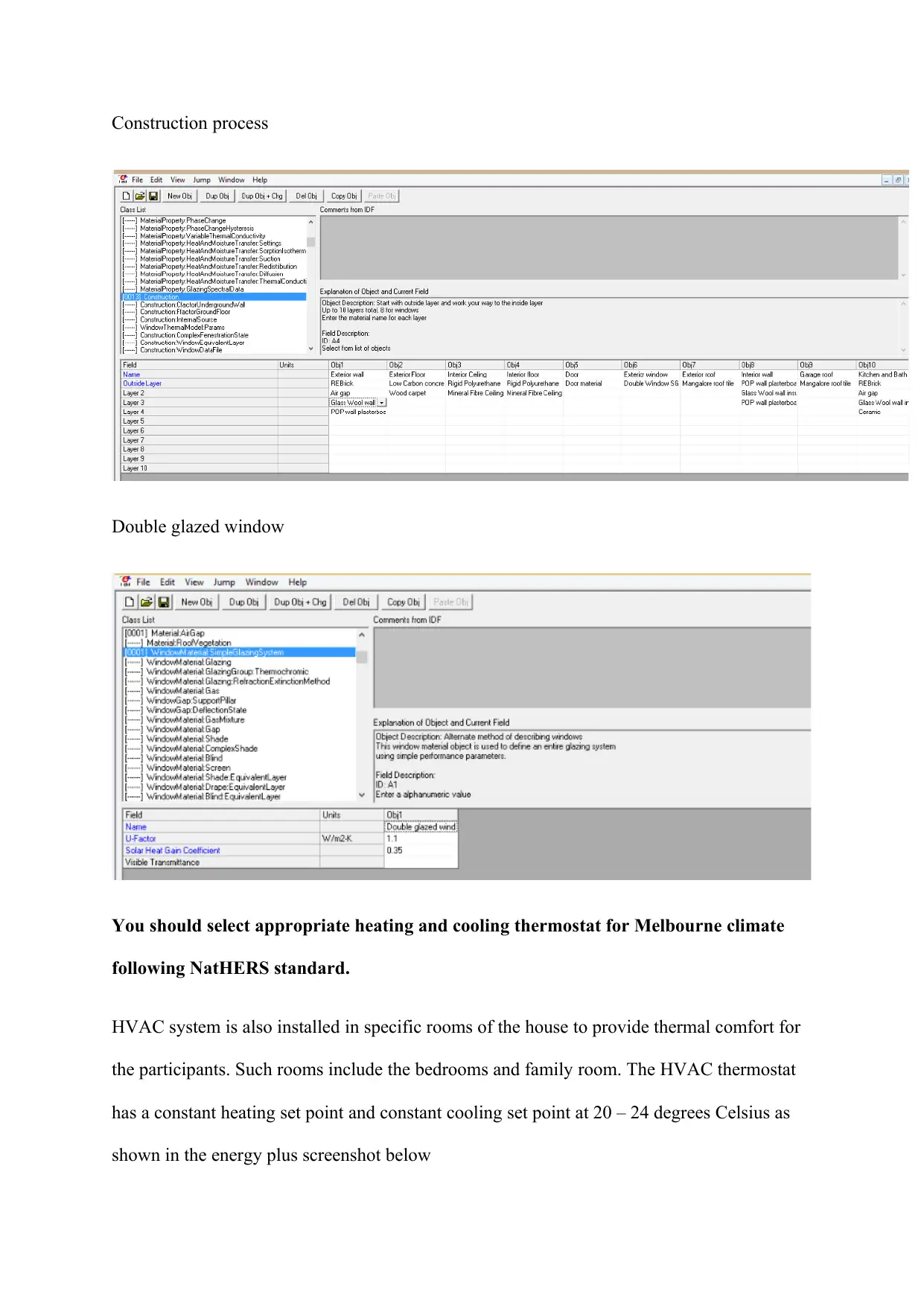
Construction process
Double glazed window
You should select appropriate heating and cooling thermostat for Melbourne climate
following NatHERS standard.
HVAC system is also installed in specific rooms of the house to provide thermal comfort for
the participants. Such rooms include the bedrooms and family room. The HVAC thermostat
has a constant heating set point and constant cooling set point at 20 – 24 degrees Celsius as
shown in the energy plus screenshot below
Double glazed window
You should select appropriate heating and cooling thermostat for Melbourne climate
following NatHERS standard.
HVAC system is also installed in specific rooms of the house to provide thermal comfort for
the participants. Such rooms include the bedrooms and family room. The HVAC thermostat
has a constant heating set point and constant cooling set point at 20 – 24 degrees Celsius as
shown in the energy plus screenshot below
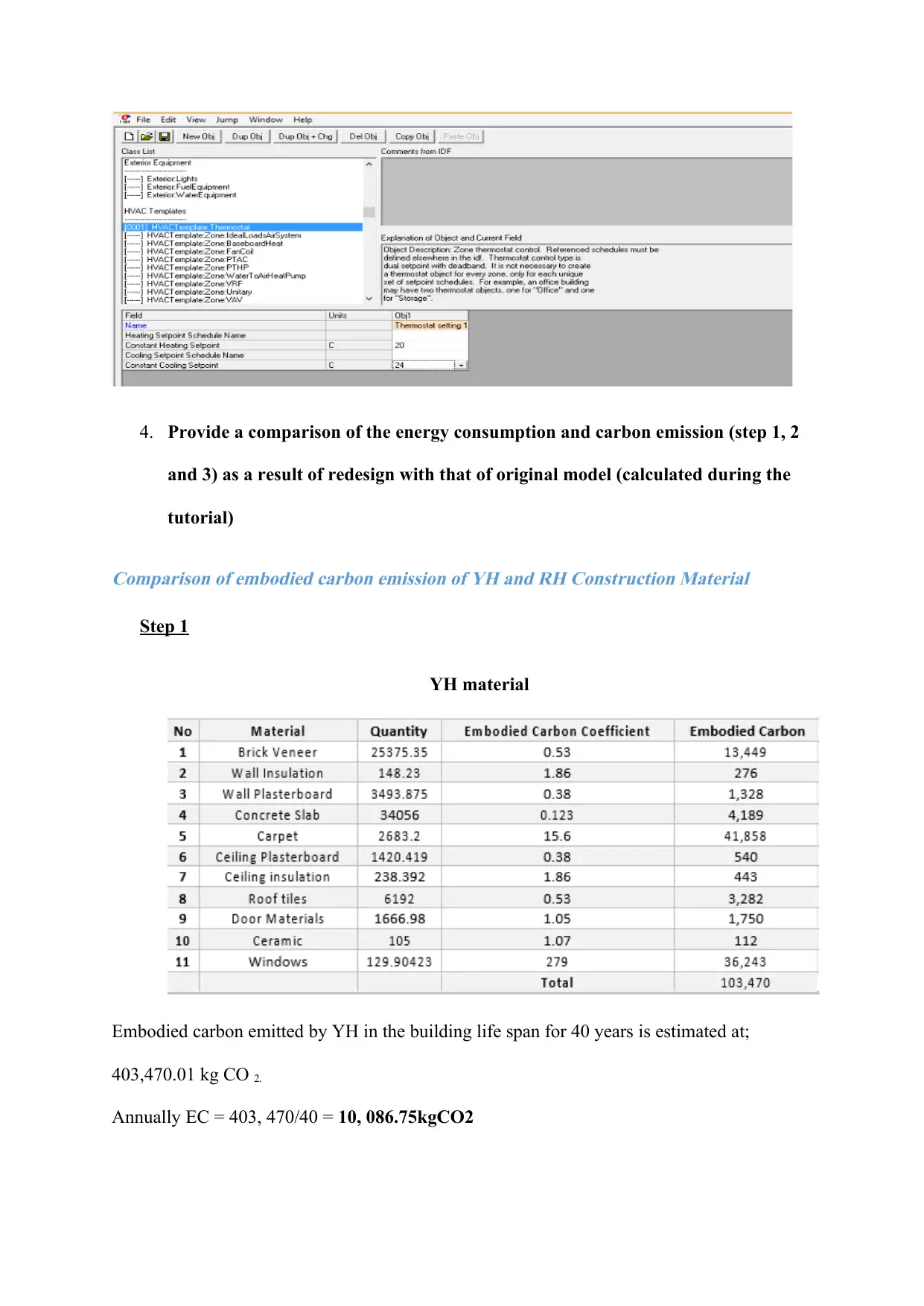
4. Provide a comparison of the energy consumption and carbon emission (step 1, 2
and 3) as a result of redesign with that of original model (calculated during the
tutorial)
Comparison of embodied carbon emission of YH and RH Construction Material
Step 1
YH material
Embodied carbon emitted by YH in the building life span for 40 years is estimated at;
403,470.01 kg CO 2.
Annually EC = 403, 470/40 = 10, 086.75kgCO2
and 3) as a result of redesign with that of original model (calculated during the
tutorial)
Comparison of embodied carbon emission of YH and RH Construction Material
Step 1
YH material
Embodied carbon emitted by YH in the building life span for 40 years is estimated at;
403,470.01 kg CO 2.
Annually EC = 403, 470/40 = 10, 086.75kgCO2
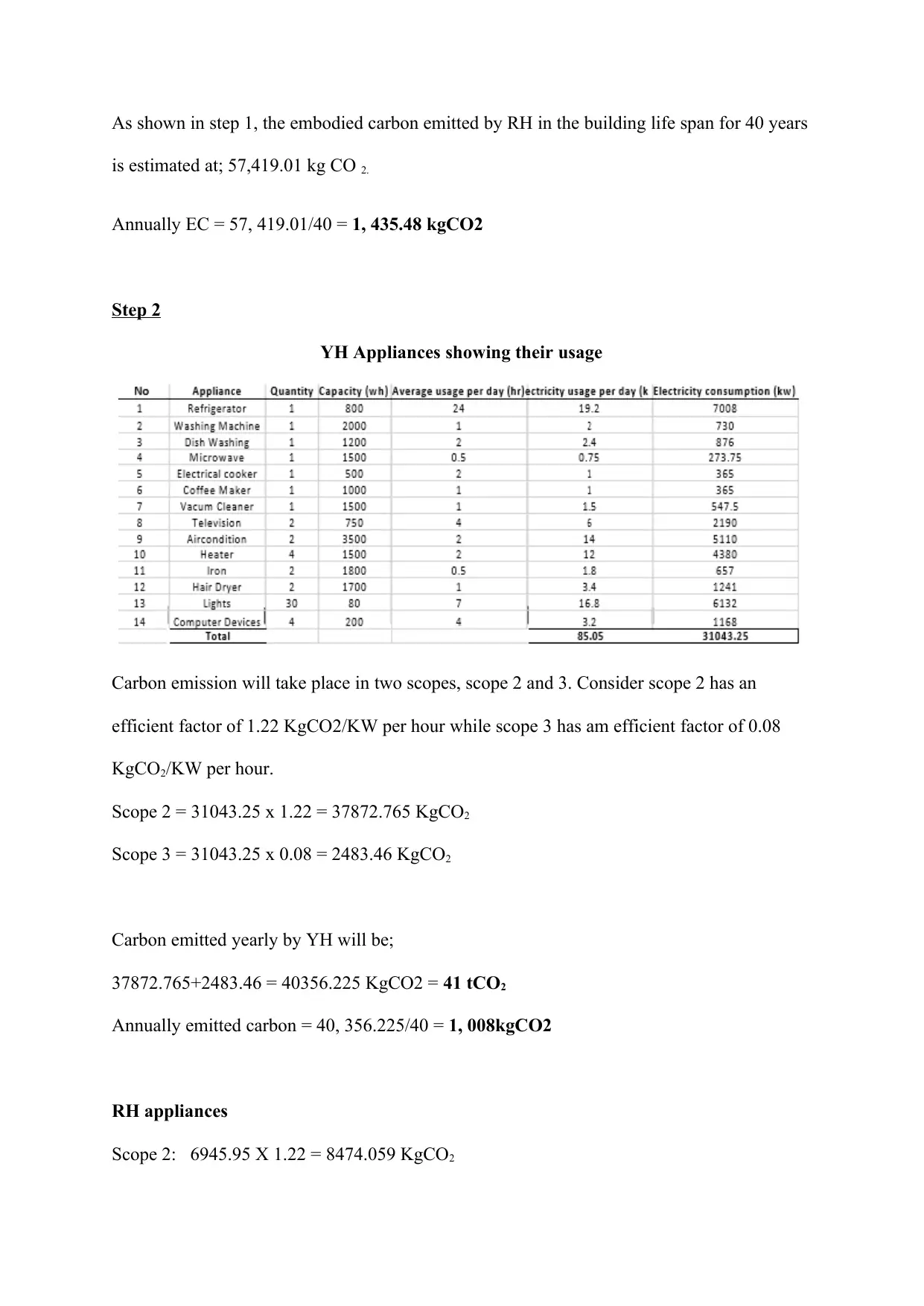
As shown in step 1, the embodied carbon emitted by RH in the building life span for 40 years
is estimated at; 57,419.01 kg CO 2.
Annually EC = 57, 419.01/40 = 1, 435.48 kgCO2
Step 2
YH Appliances showing their usage
Carbon emission will take place in two scopes, scope 2 and 3. Consider scope 2 has an
efficient factor of 1.22 KgCO2/KW per hour while scope 3 has am efficient factor of 0.08
KgCO2/KW per hour.
Scope 2 = 31043.25 x 1.22 = 37872.765 KgCO2
Scope 3 = 31043.25 x 0.08 = 2483.46 KgCO2
Carbon emitted yearly by YH will be;
37872.765+2483.46 = 40356.225 KgCO2 = 41 tCO2
Annually emitted carbon = 40, 356.225/40 = 1, 008kgCO2
RH appliances
Scope 2: 6945.95 X 1.22 = 8474.059 KgCO2
is estimated at; 57,419.01 kg CO 2.
Annually EC = 57, 419.01/40 = 1, 435.48 kgCO2
Step 2
YH Appliances showing their usage
Carbon emission will take place in two scopes, scope 2 and 3. Consider scope 2 has an
efficient factor of 1.22 KgCO2/KW per hour while scope 3 has am efficient factor of 0.08
KgCO2/KW per hour.
Scope 2 = 31043.25 x 1.22 = 37872.765 KgCO2
Scope 3 = 31043.25 x 0.08 = 2483.46 KgCO2
Carbon emitted yearly by YH will be;
37872.765+2483.46 = 40356.225 KgCO2 = 41 tCO2
Annually emitted carbon = 40, 356.225/40 = 1, 008kgCO2
RH appliances
Scope 2: 6945.95 X 1.22 = 8474.059 KgCO2
Paraphrase This Document
Need a fresh take? Get an instant paraphrase of this document with our AI Paraphraser
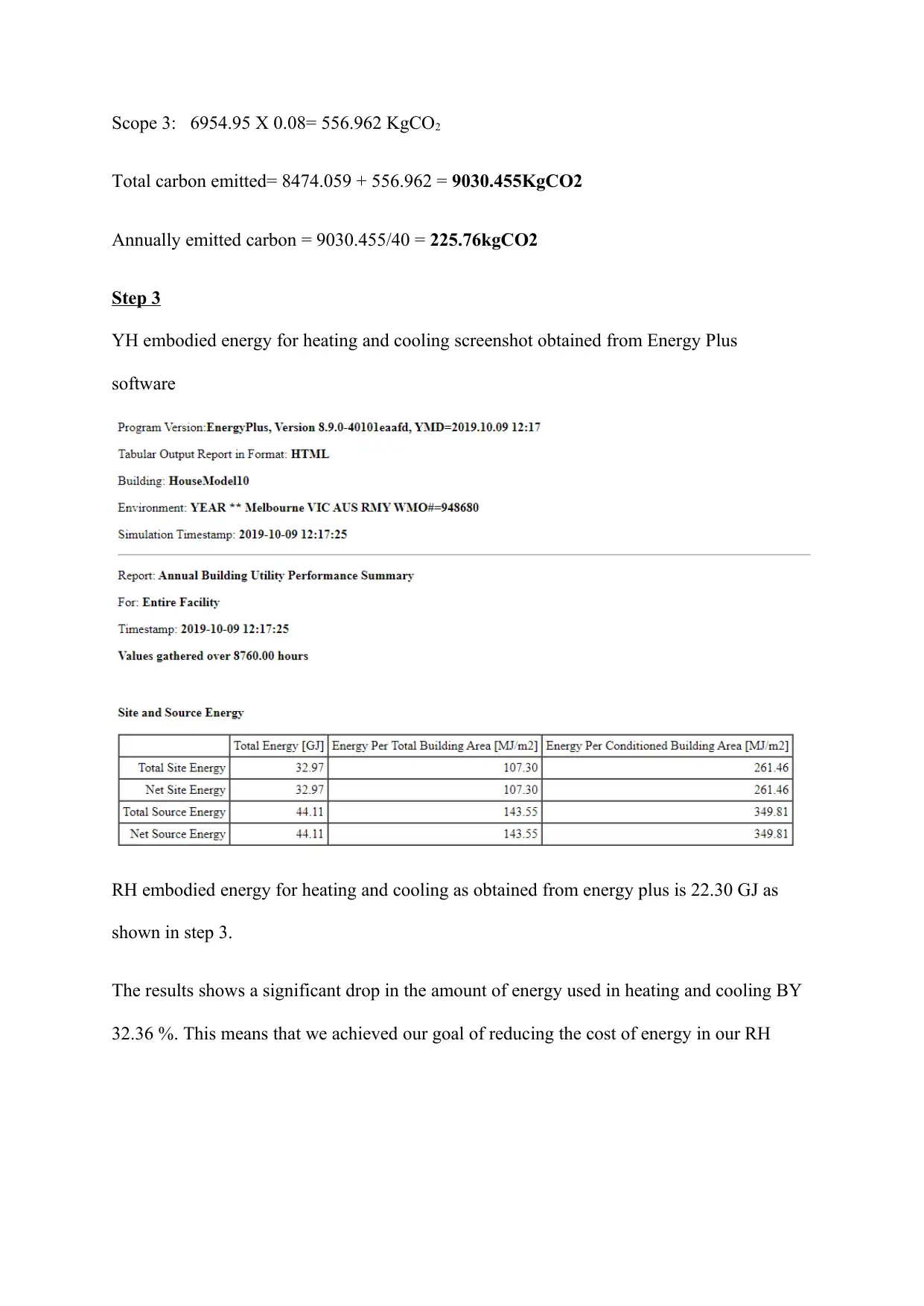
Scope 3: 6954.95 X 0.08= 556.962 KgCO2
Total carbon emitted= 8474.059 + 556.962 = 9030.455KgCO2
Annually emitted carbon = 9030.455/40 = 225.76kgCO2
Step 3
YH embodied energy for heating and cooling screenshot obtained from Energy Plus
software
RH embodied energy for heating and cooling as obtained from energy plus is 22.30 GJ as
shown in step 3.
The results shows a significant drop in the amount of energy used in heating and cooling BY
32.36 %. This means that we achieved our goal of reducing the cost of energy in our RH
Total carbon emitted= 8474.059 + 556.962 = 9030.455KgCO2
Annually emitted carbon = 9030.455/40 = 225.76kgCO2
Step 3
YH embodied energy for heating and cooling screenshot obtained from Energy Plus
software
RH embodied energy for heating and cooling as obtained from energy plus is 22.30 GJ as
shown in step 3.
The results shows a significant drop in the amount of energy used in heating and cooling BY
32.36 %. This means that we achieved our goal of reducing the cost of energy in our RH
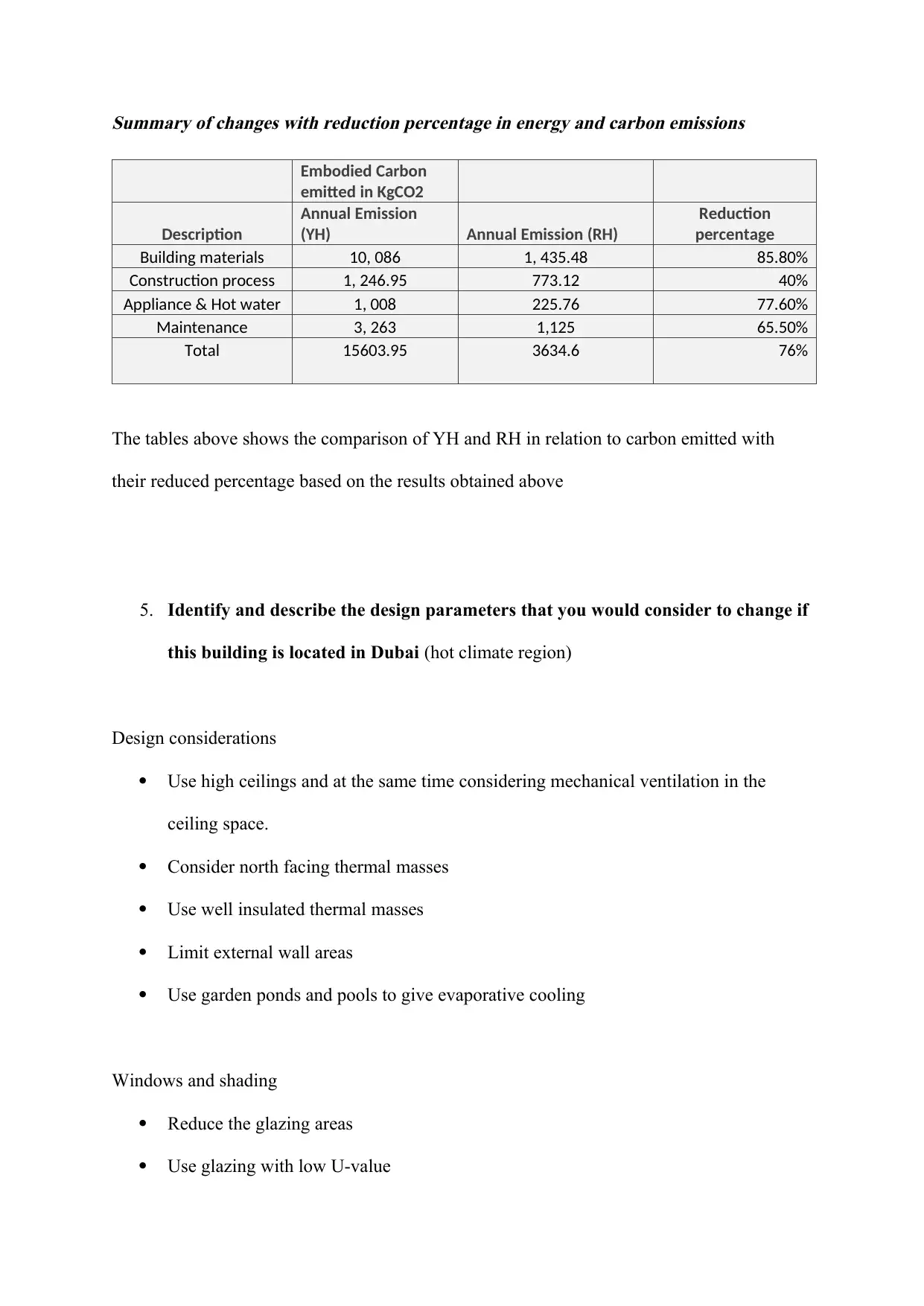
Summary of changes with reduction percentage in energy and carbon emissions
Embodied Carbon
emitted in KgCO2
Description
Annual Emission
(YH) Annual Emission (RH)
Reduction
percentage
Building materials 10, 086 1, 435.48 85.80%
Construction process 1, 246.95 773.12 40%
Appliance & Hot water 1, 008 225.76 77.60%
Maintenance 3, 263 1,125 65.50%
Total 15603.95 3634.6 76%
The tables above shows the comparison of YH and RH in relation to carbon emitted with
their reduced percentage based on the results obtained above
5. Identify and describe the design parameters that you would consider to change if
this building is located in Dubai (hot climate region)
Design considerations
Use high ceilings and at the same time considering mechanical ventilation in the
ceiling space.
Consider north facing thermal masses
Use well insulated thermal masses
Limit external wall areas
Use garden ponds and pools to give evaporative cooling
Windows and shading
Reduce the glazing areas
Use glazing with low U-value
Embodied Carbon
emitted in KgCO2
Description
Annual Emission
(YH) Annual Emission (RH)
Reduction
percentage
Building materials 10, 086 1, 435.48 85.80%
Construction process 1, 246.95 773.12 40%
Appliance & Hot water 1, 008 225.76 77.60%
Maintenance 3, 263 1,125 65.50%
Total 15603.95 3634.6 76%
The tables above shows the comparison of YH and RH in relation to carbon emitted with
their reduced percentage based on the results obtained above
5. Identify and describe the design parameters that you would consider to change if
this building is located in Dubai (hot climate region)
Design considerations
Use high ceilings and at the same time considering mechanical ventilation in the
ceiling space.
Consider north facing thermal masses
Use well insulated thermal masses
Limit external wall areas
Use garden ponds and pools to give evaporative cooling
Windows and shading
Reduce the glazing areas
Use glazing with low U-value
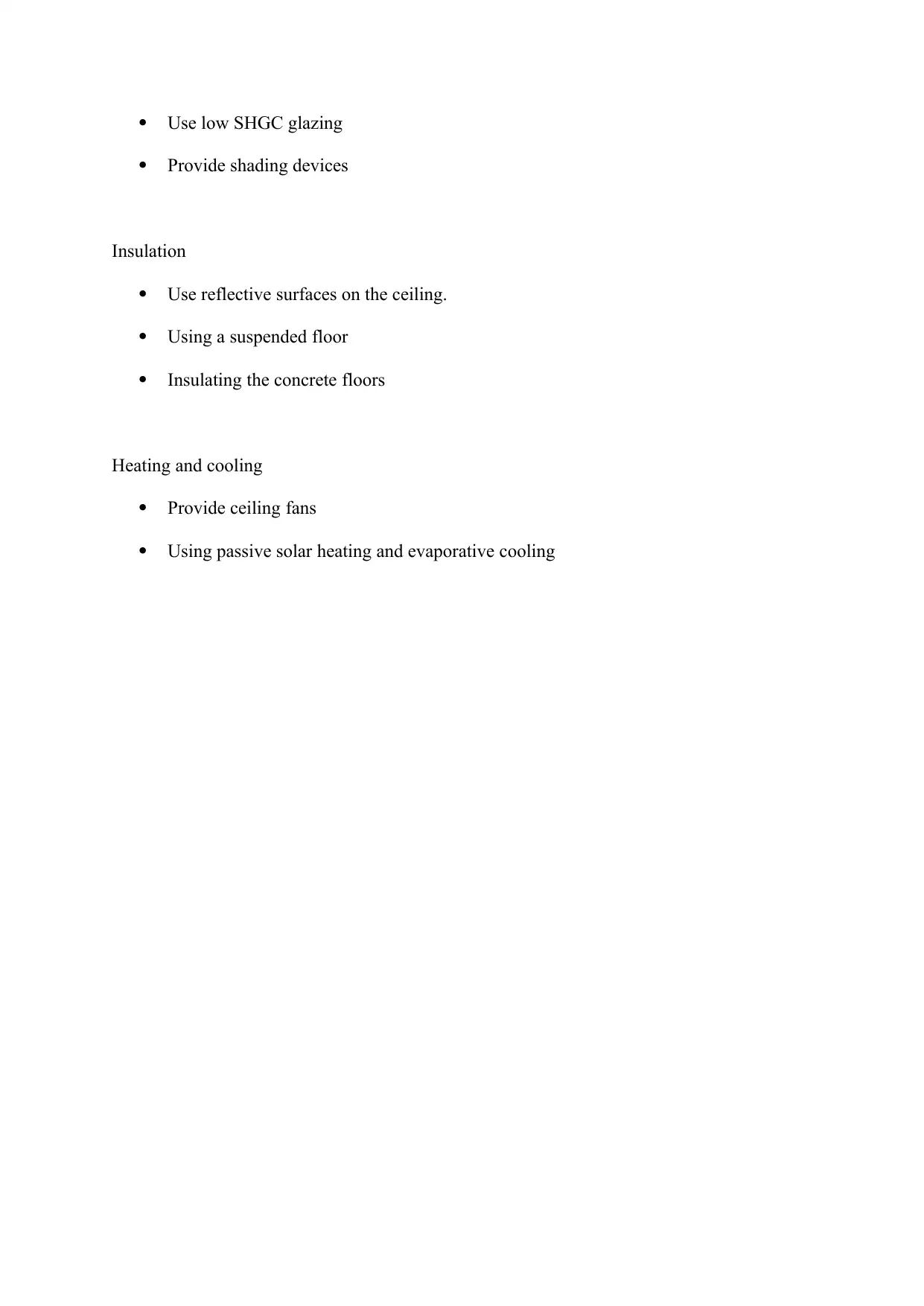
Use low SHGC glazing
Provide shading devices
Insulation
Use reflective surfaces on the ceiling.
Using a suspended floor
Insulating the concrete floors
Heating and cooling
Provide ceiling fans
Using passive solar heating and evaporative cooling
Provide shading devices
Insulation
Use reflective surfaces on the ceiling.
Using a suspended floor
Insulating the concrete floors
Heating and cooling
Provide ceiling fans
Using passive solar heating and evaporative cooling
Secure Best Marks with AI Grader
Need help grading? Try our AI Grader for instant feedback on your assignments.
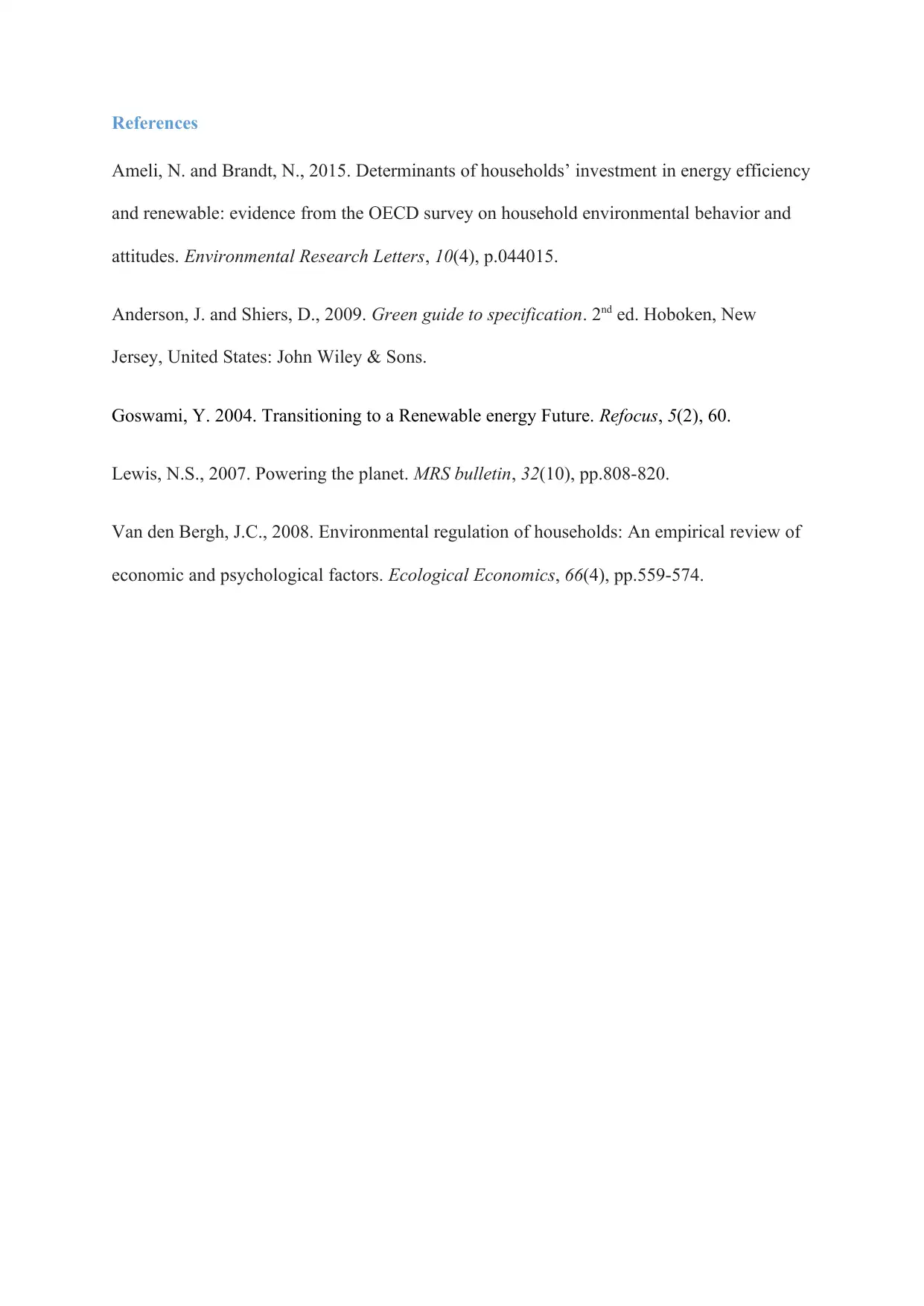
References
Ameli, N. and Brandt, N., 2015. Determinants of households’ investment in energy efficiency
and renewable: evidence from the OECD survey on household environmental behavior and
attitudes. Environmental Research Letters, 10(4), p.044015.
Anderson, J. and Shiers, D., 2009. Green guide to specification. 2nd ed. Hoboken, New
Jersey, United States: John Wiley & Sons.
Goswami, Y. 2004. Transitioning to a Renewable energy Future. Refocus, 5(2), 60.
Lewis, N.S., 2007. Powering the planet. MRS bulletin, 32(10), pp.808-820.
Van den Bergh, J.C., 2008. Environmental regulation of households: An empirical review of
economic and psychological factors. Ecological Economics, 66(4), pp.559-574.
Ameli, N. and Brandt, N., 2015. Determinants of households’ investment in energy efficiency
and renewable: evidence from the OECD survey on household environmental behavior and
attitudes. Environmental Research Letters, 10(4), p.044015.
Anderson, J. and Shiers, D., 2009. Green guide to specification. 2nd ed. Hoboken, New
Jersey, United States: John Wiley & Sons.
Goswami, Y. 2004. Transitioning to a Renewable energy Future. Refocus, 5(2), 60.
Lewis, N.S., 2007. Powering the planet. MRS bulletin, 32(10), pp.808-820.
Van den Bergh, J.C., 2008. Environmental regulation of households: An empirical review of
economic and psychological factors. Ecological Economics, 66(4), pp.559-574.
1 out of 17
Related Documents
Your All-in-One AI-Powered Toolkit for Academic Success.
+13062052269
info@desklib.com
Available 24*7 on WhatsApp / Email
![[object Object]](/_next/static/media/star-bottom.7253800d.svg)
Unlock your academic potential
© 2024 | Zucol Services PVT LTD | All rights reserved.




